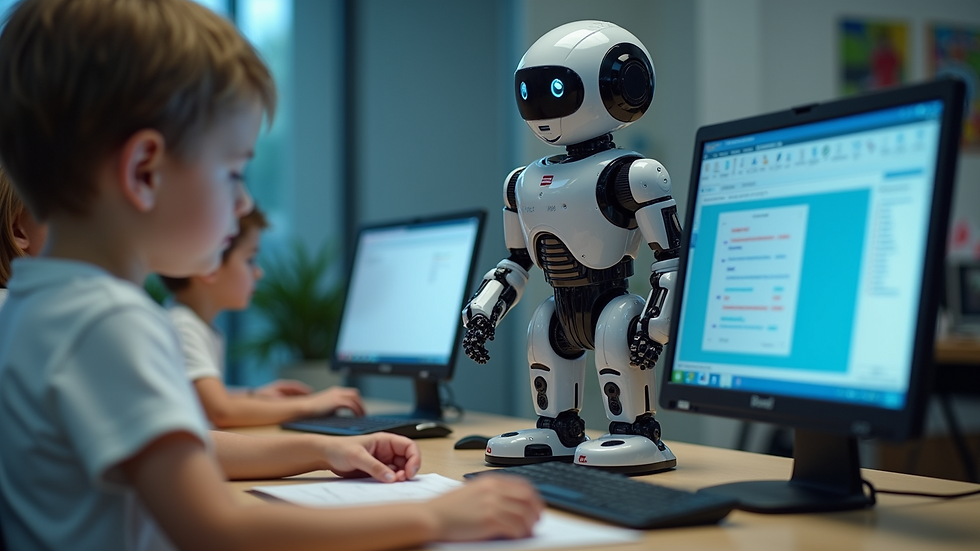Foster Problem-Solving and Teamwork with STEM Robotics
- Franklin Qi
- Jul 26
- 3 min read
In today's fast-paced world, the ability to solve problems and work as a team is more important than ever. One of the most effective ways to develop these skills in young learners is through STEM robotics. This engaging field combines science, technology, engineering, and mathematics to create hands-on learning experiences.
STEM robotics not only teaches students about technology but also encourages them to think critically and collaborate with their peers. In this blog post, we will explore how robotics can foster problem-solving and teamwork, providing practical examples and insights along the way.
The Importance of Problem-Solving Skills
Problem-solving is a crucial skill that students need to develop. It helps them navigate challenges in school and prepares them for real-world situations.
When students engage in robotics, they encounter various problems that require creative solutions. For instance, they may need to program a robot to navigate a maze. This task involves identifying obstacles, planning a route, and troubleshooting any issues that arise.
By working through these challenges, students learn to think critically and approach problems from different angles. They also gain confidence in their ability to find solutions, which is invaluable in any field.
Teamwork in Robotics
Teamwork is another essential skill that robotics promotes. In a robotics project, students often work in groups to design, build, and program their robots. This collaborative environment encourages communication and cooperation.
For example, one student might focus on the robot's design, while another handles programming. They must share ideas, listen to each other, and make decisions together. This process teaches them how to work effectively as a team, which is a skill that will benefit them throughout their lives.
Hands-On Learning Experiences
One of the most exciting aspects of STEM robotics is the hands-on learning experience it provides. Students are not just passive learners; they actively engage with the material.
Consider a classroom where students are tasked with building a robot that can pick up objects. They must gather materials, brainstorm designs, and test their creations. This process allows them to apply theoretical knowledge in a practical setting.
Hands-on learning also makes the experience more enjoyable. When students are excited about what they are doing, they are more likely to stay engaged and motivated.
Real-World Applications
STEM robotics has real-world applications that extend beyond the classroom. Many industries rely on robotics and automation, making these skills highly relevant.
For instance, in the field of medicine, robots are used for surgeries and patient care. In manufacturing, robots help assemble products efficiently. By learning about robotics, students gain insights into these industries and the skills they need to succeed.
Moreover, understanding robotics can inspire students to pursue careers in STEM fields. This exposure can lead to a new generation of engineers, programmers, and innovators.
Encouraging Creativity
Robotics also encourages creativity. Students are often given the freedom to design their robots in unique ways. This creative aspect allows them to express themselves and think outside the box.
For example, a student might decide to build a robot that can dance. This project requires not only technical skills but also artistic vision. By combining creativity with technology, students learn to approach problems in innovative ways.
Building Resilience
Working on robotics projects can be challenging. Students may face setbacks, such as a robot that does not function as expected. These experiences teach them resilience.
When students encounter difficulties, they learn to persevere and find alternative solutions. This resilience is a valuable life skill that will serve them well in all areas of life.
The Role of Educators
Educators play a crucial role in fostering problem-solving and teamwork through STEM robotics. They can create an environment that encourages exploration and experimentation.
Teachers can provide guidance and support while allowing students the freedom to make mistakes and learn from them. This balance is essential for developing independent thinkers who are not afraid to tackle challenges.
Community Involvement
Involving the community can enhance the robotics experience for students. Local businesses and organizations can partner with schools to provide resources, mentorship, and real-world insights.
For example, a local engineering firm might sponsor a robotics competition, offering students the chance to showcase their skills. This involvement not only enriches the learning experience but also strengthens community ties.
Conclusion: A Bright Future with STEM Robotics
STEM robotics is more than just a fun activity; it is a powerful tool for developing essential skills. By fostering problem-solving and teamwork, robotics prepares students for success in school and beyond.
As we continue to embrace technology in education, it is vital to recognize the value of hands-on learning experiences. With the right support and resources, we can inspire the next generation of innovators and problem solvers.
Let us encourage our students to explore the exciting world of robotics and watch them thrive.



Commenti